The History Of JEEP Cherokee

The Jeep Cherokee (XJ) is a unibody (monocoque) compact SUV. It shared the name of the original full-size SJ model, but without a body-on-frame chassis, it set the stage for the modern SUV. Its innovative appearance and sales popularity spawned important imitators as other automakers began to notice that this model began replacing regular cars. It was built in Toledo, Ohio in the United States and in Beijing, China. The XJ platform provided the mechanical basis for the MJ-series Jeep Comanche pick-up.
The XJ was selected by Robert Cumberford of Automobile Magazine as one of the 20 greatest cars of all time, calling it "possibly the best SUV shape of all time, it is the paradigmatic model to which other designers have since aspired."
Designs of the XJ Cherokee date back to 1978 when a team of American Motors (AMC) and Renault engineers drew several sketches. A few clay models were based on the existing SJ Cherokee. Early sketches of the XJ Cherokee had an European influence, and most of the styling cues were done by AMC engineers under the direction of Richard Teague. The ongoing debate suggests that Renault sketch artists were involved right after the 1979 partnership with AMC.[citation needed] Noticing that General Motors was developing a new two-door S-10 based Blazer, AMC decided to design an entirely new four-door model, but worried about rollovers Gerald C. Meyers hired one of Ford's best engineers, Roy Lunn to design what is known as the Quadra-Link suspension. François Castaing developed the drivetrain using a much smaller engine than normally found in 4WD vehicles and reduced the weight of the new model,
The XJ Cherokee introduced in 1984 was the first Jeep with a ladder-boxed chassis integrated into a single monocoque unit rather than the traditional separate body-on-frame construction.
Both two- and four-door versions of the XJ Cherokee were offered throughout its lifetime, each having exactly the same track and wheelbase measurements. Two-door models, however, received longer doors and front seats that could fold forward to assist in rear passenger entry and exit. This was in addition to extended-length rear windows that did not open, although an optional rear vent window was available on some models. Its appearance has led some to mistakenly believe that the two-door models are a short wheelbase version of the four-door.
A variation on the Cherokee from 1984 through 1990 was the Jeep Wagoneer. These were unrelated to the similarly named full-sized Grand Wagoneer models. The compact XJ Wagoneer was available in two trim levels: the "Wagoneer" and the "Wagoneer Limited". Both Wagoneers were distinguished from the Cherokee models by their four headlights. The Wagoneer Limited came with vinyl wood trim on the sides and leather seats embossed with "limited".
This version was the first to be sold in Europe; it was launched in 1992 in some markets, 1993 for the United Kingdom. Early versions had the 4.0L (242CID) six-cylinder engine only: the 2.5L (150CID) engine did not arrive in Europe until 1995.
In mid 1985 a two wheel drive version of the Cherokee was added to the line-up. This was done in the hopes of attracting a few more buyers who didn't need (or want to pay for) four wheel drive. When the XJ Cherokee based Comanche (MJ) truck was introduced it was also available in two and four wheel drive. Jeep had stopped making two wheel drive Wagoneers and pickups in 1967. The new two wheel drive models shared the front suspension with four wheel drive models. Jeep simply used a single axle tube from hub to hub with no differential between, resulting in a low added cost front suspension.
American Motors's compact XJ Cherokee was to be replaced by a new and larger model known as the ZJ (later named the Jeep Grand Cherokee when introduced in 1993) that was under development by AMC. However, the smaller model's continuing popularity caused Chrysler executives, as the new owners of AMC, to rethink this decision. The Jeep XJ has remained a popular choice by off-roading enthusiasts due to its potent off-roading capability in stock form. Its popularity has resulted in strong ongoing aftermarket support in the form of a wide variety of products and upgrade availability.
Engines
- 1984-1985 2.5L, 150CID AMC150 I4, Carbureted 105 hp
- 1986-1990 2.5L, 150CID AMC150 I4, TBI (fuel injected) 117 hp updated in 87-90 to 121hp
- 1984-1986 2.8L GM 60° LR2 V6, 110hp (82kW)
- 1985-1987 2.1L Renault turbodiesel I4 (initially sold in U.S. and until 1993 in Europe)
- 1987-1990 4.0L, 242CID AMC242 I6, 173 hp with Renix fuel injection system
- 1991-1996 4.0L, 242CID AMC242 "High Output" I6, 190hp (142kW) with Chrysler fuel injection system
- 1994-1996 2.5L VM Motori turbodiesel with intercooler I4, 118hp (sold in Europe and South America)
HP 280, LB 350
After 13 years of production, 1997 saw the Cherokee receive updated exterior and interior styling. Both the two- and four-door bodies remained in production, receiving a steel liftgate (replacing the fiberglass one used previously),a new taillight design, additional plastic molding along the doors, as well as a new front header panel that featured more aerodynamic styling.
The interior was similarly updated with an all-new design and instruments, and a stiffer unibody frame brought improvements to Noise, Vibration, and Harshness (NVH) measurements. Also contributing to NVH improvements were new door seals that reduced wind noise at higher speeds.
In the middle of the 1999 model year, vehicles with the 4.0 liter (242CID) engine received a much improved intake manifold. This was done to help counteract smaller exhaust porting on the latest casting of cylinder heads, which was done to meet more stringent emissions control laws. Both the 4- and 6-cylinder engines were offered through the 2000 model year, though only the straight-six was available in 2001. For the 2000 and 2001 model years, all six-cylinder XJs received a distributorless ignition system using coil-on-plug ignition replacing the 'traditional' system previously used; coupled with better exhaust porting and the newer intake manifolds, this gave a minor increase in power over the previous models. Transmission, axle, and transfer case choices were carried over from the previous models.
However, major changes were underway with a new executive, Wolfgang Bernhard, who was known as a "cost-slasher" nicknamed "whirlwind", came from Mercedes-Benz to turn around Chrysler. "One of the first moves Bernhard made when he came to Chrysler in 2000 was to help kill the Jeep Cherokee, an aging somewhat bland SUV." Thus, the (XJ) Cherokee line was replaced in 2002 by the Jeep Liberty (KJ) , although it is called the "Cherokee" in most foreign markets.
When (XJ) Cherokee production ended in mid 2001, the portion of the Toledo South Assembly Plant devoted to its production was slowly torn down.
Engines
- 1984-1985 2.5L (150CID) I4 carbureted - 105 hp @ 5000 rpm, 132 ft lb torque @ 2800 rpm
- 1986-1990 2.5L (150CID) I4 TBI (fuel injected) - 117 hp @ 5000 rpm, 135 ftlb @ 3500 rpm updated in 87-90 to 121hp
- 1991-2000 2.5L (150CID) I4 MPI (multi-port injection) - 130 hp @ 5250 rpm, 139 ft lb @ 3250 rpm
- 1984-1986 GM 2.8L V6 - 115 hp @ 4800 rpm, 145 ft lb @ 2400 rpm
- 1985-1987 Renault 2.1L 4cyl. Turbo Diesel - 85 hp @ 3750 rpm, 132 ft lb @ 2750 rpm
- 1987-1990 4.0L (242CID) I6 RENIX FI 242ci - 173 hp @ 4750 rpm, 215 ft lb @ 4000 rpm
- 1991-1995 4.0L (242CID) I6 MPI (High Output) - 190 hp @ 4750 rpm, 220 ft lb @ 4,000 rpm
- 1996-1999 4.0L (242CID) I6 MPI (High Output) **Chrysler Block Cast** - 190 hp @ 4750 rpm, 235 ft lb @ 3,000 rpm
- 2000-2001 4.0L (242CID) I6 MPI "Power Tech" - 193 hp @ 4750 rpm, 245 ft lb @ 4,000 rpm
Foreign Engines
- 1984-1986 2.1L Renault turbodiesel I4
- 1997-2000 2.5L (150CID) AMC150 I4, 130hp (97kW)
- 1997-2001 2.5L VM Motori turbodiesel I4 (sold in Europe, Australia and South America)
- 1997-1999 4.0L (242CID) 242 I6, 190hp (142kW)
- 2000-2001 4.0L (242CID) 242Power Tech I6, 193hp (144kW)
Not available in the US Italian VM 2.5L Turbo Diesel - 140 hp, 236 ft lb torque
Trim levels
- Base - 1984-1993
- SE - 1994-2000
- Wagoneer - 1984-1990
- Briarwood - 1991-1992
- Pioneer - 1984-1990
- Pioneer Olympic Edition - 1988
- Chief - 1984-1990
- Sport - 1988-2001
- Country - 1993-1997
- Classic - 1996, 1998-2001
- Limited - 1987-1992, 1998-2001
- Laredo - 1985-1992
- Freedom - 2000
- 60th Anniversary - 2001
Manual transmissions
- 1984-only: Borg-Warner T-4 4-speed manual, used with 2.5L I4 only, 21 spline output.
- 1984 – 1987: Aisin-Warner AX4 4-speed manual, used with 2.5L I4 only, 21 spline output.
- 1984-only: Borg-Warner T-5 5-speed manual, used with 2.5L I4 and 2.8L V6, 21 spline output.
- 1984 – 2000: Aisin-Warner AX5 5-speed manual, used with 2.5L I4, 2.1L I4 diesel, and 2.8L V6, 21 spline output.
- 1987 – Mid-1989: Peugeot BA-10/ 5 5-speed manual used with 4.0L I6, 21 spline output.
- Late-1989 – 1999: Aisin-Warner AX15 5-speed manual, used with 2.5L I4 diesel, 4.0L I6, 23 spline output.
- 2000 – 2001: New Venture Gear NV3550 5-speed manual, used with 2.5L I4 diesel, 4.0L I6, 23 spline output.
Automatic transmissions
- 1984 – 1986: Chrysler A904 3-speed automatic, used with 2.5L I4 and 2.8L V6.
- 1987 – 2001: Aisin-Warner AW-4 4-speed automatic, used with 2.5L I4 and 4.0L I6.
- 1994 – 2000: Chrysler 30RH 3-speed automatic, used with 2.5L I4.
Transfer cases
All the transfer cases used on the Cherokee were chain driven with aluminum housings. Command-Trac was standard on XJ models built with 4WD.
- 1984 – 1987: New Process NP207 "Command-Trac", part-time only, 2.61:1 ratio with low range
- 1987 – 2001: New Process NP231 "Command-Trac", part-time only, 2.72:1 ratio with low range
- 1987 – 2001: New Process NP242 "Selec-Trac", full-time/ part-time, 2.72:1 ratio with low range
Axles
The Jeep XJ utilizes front and rear solid (live) axles as opposed to independent front and/ or rear axles. This configuration allows the XJ to have superior off-road capability and performance at the expense of some on-road comfort and drivability. Mid-1985 and later two wheel drive models used the same basic suspension with a single tube connecting axle ends with no differential.
Front Axle
- 1984 – 1996: Dana 30, High Pinion, Reverse Cut, 27-spline axleshafts (1989 – 1995: with ABS used 5-297x universal joints, non-ABS had 5-260x universal joints. Note: Certain XJ models were produced with constant-velocity joints instead of universal joints.)
- 1996 – 1999: Dana 30, High Pinion, Reverse Cut, 297x/ 760 universal joint, 27-spline axleshafts.
- 2000 – 2001: Dana 30, Low Pinion, Standard Cut, 297x/ 760 universal joint, 27-spline axleshafts.
- 1985 – 2001: Straight non-driven front axle for two wheel drive only.
Rear Axle
- 1984 – 1989: Dana 35, non c-clip, with anti-lock braking system (ABS) or non-ABS.
- 1990 – 1996: Dana 35, c-clip, ABS or non-ABS.
- 1997 – 2001: Dana 35, c-clip, ABS.
- 1991 – 1996: Chrysler 8.25", c-clip, non-ABS, 27-spline axleshafts.
- 1997 – 2001: Chrysler 8.25", c-clip, non-ABS, 29-spline axleshafts.
- 1987 – 1990: Dana 44, non-abs, 30-spline axleshafts.
Axle Gear Ratios
Jeep XJs came in several standard gearing ratios:
- 3.07:1, manual transmission, I6 engine.
- 3.54:1, automatic transmission, I6 engine with Dana 44 rear differential.
- 3.54:1, manual transmission, I4 diesel engine with Dana 35 rear differential.
- 3.55:1, automatic transmission, I6, V6 engines; manual transmission, I4 engine.
- 3.73:1, automatic transmission, I6, Tow Package, UpCountry Package.
- 4.10:1, manual transmission, V6; automatic transmission, I4 engine.
- 4.56:1, automatic transmission, I4, offroad or tow package.
Suspension
The Jeep XJ utilizes a coil spring front suspension with a leaf spring rear suspension.
Front Suspension
The Jeep XJ utilizes the Quadra-Link front suspension. This suspension design locates the axle with four control arms to control up and down movement, two above the axle and two below it. A panhard rod, also referred to as a track bar, is used to locate the axle central to the vehicle. Two coil springs are seated on top of the axle housing as well as two gas-charged shock absorbers. A sway bar is utilized to reduce body roll in turns.
Rear Suspension
The XJ uses a leaf spring rear suspension. Each leaf pack contains four leaf springs with a fixed eye at the front of the spring and a shackle at the rear of the spring. Two gas-charged shock absorbers are also used, along with a mild anti-sway/ anti-roll bar. The suspension used on vehicles with the optional UpCountry Package did not employ the rear anti-sway/ anti-roll bar and provided one inch of lift over the standard suspension.
A van version of the XJ was offered in addition to the standard vehicles in some European markets. Available in both right- and left-hand-drive models, they were designed to comply with relaxed motor tax regulations in some EU member states governing vehicles intended for primarily commercial use. Both two- and four-door versions are known to have been sold, with the main differences from the standard models being metal panels in place of the rear side windows, no rear seats, and a completely flat cargo area. Two- and four-wheel-drive variants were available, powered by the VM Motori 2.5-litre diesel engine mated to the Aisin AX-5 manual transmission. Photographs of this model can be found here.
The XJ was sold in Europe from 1985 until 2001 (1993-2001 for some markets).
American Motors established the first automobile manufacturing joint venture in the People's Republic of China to assemble the four-door Cherokee. Production continued after Chrysler's buyout of AMC. Chrysler executives were concerned over licit and illicit technology transfers when knock-offs of the Cherokee began appearing in the Chinese market. Production under Mercedes-Benz continued in the partnership that was renamed Beijing-Benz DaimlerChrysler Automotive. The most recent model with an updated grille, headlights, and other upgrades was known as the "Jeep 2500". that was produced until 2005. It is notable that AMC's original Cherokee design continued to sell virtually unchanged after over twenty years.
From Wikipedia, the free encyclopedia
More About JEEP Cherokee

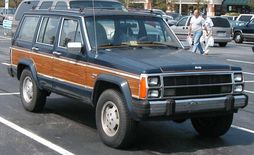
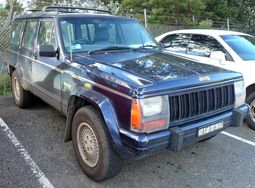
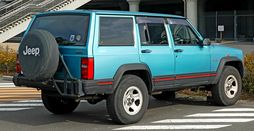
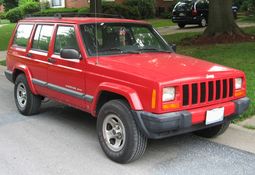

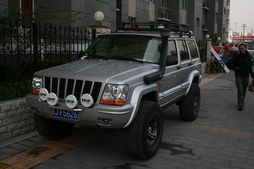
|